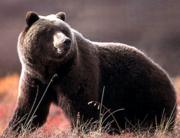

Genus: Ursus
Species: arctos horribilis

Most bears are found in North America and Eurasia. Grizzlies are found on the Alaskan and northwestern Canadian tundra. They are considered a subspecies of the brown bear. Most grizzly bears are found in the northwestern part of North America. The grizzly bear's habitat can include forests, mountains, meadows, and valleys.
Grizzly bears have amazing physical strength and are surprisingly fast over short distances. They are very aggressive and have no trouble driving away predators like wolves and mountain lions. The grizzly also has a great sense of smell.
The grizzly has a heavy, stout body, a big head, and short tail. It has a distinctive hump between its shoulder blades. Its nose is dished, and turns up at the end, unlike the black bear, whose nose arches down. Most are brown, black, or blond. The tundra grizzly is often creamy yellow on the back with brownish legs and underparts. They can weigh up to 704 lbs, be over 8 feet in length, and stand 3 1/2 feet high at the shoulders. They are well suited to the cold climate of the tundra. Besides having a thick, shaggy coat of hair, they have layers of fat to insulate them. When winter comes the grizzly will bed down in a den packed with leaves and sticks. It doesn't go into full hibernation, and will occasionally come out of its den. It doesn't eat during this time but lives off stored body-fat until spring.
Grizzly bears have an amazing diet. Scientists discovered that 75% of the bear population live off plants alone. The grizzly will also eat insects, small rodents and honey. It is strong enough to kill a caribou and outrun a moose, but usually it doesn't hunt. It will eat abandoned kills made by other predators (by driving the predator away from its kill).
Females have cubs at around age five. She will give birth to 2 - 4 cubs, but usually twins in January. They weigh about 1 lb at birth and will suckle until May. The cubs stay with the mother until age 2 and then go off alone and repeat the cycle. Their life span is around 25 years.
The grizzly bear is a solitary animal because it doesn't need to form protective packs because it lacks natural enemies.
The population of the grizzly bear began to decline since the early 1800s. Around the 1970s there were only about 300 grizzlies left in the United States, outside Alaska. The US Fish and Wildlife Service lists the grizzly bear as an endangered species, except in Alaska. The grizzly bear population is now increasing in Yellowstone Park.
by Max S. 2000
Bibliography:
"Grizzly Bear". Wildlife Explorer. USA : International Masters Publishers Inc. 1998.
Photo Credit: Brian Wolitski, http://www.bmwphoto.com